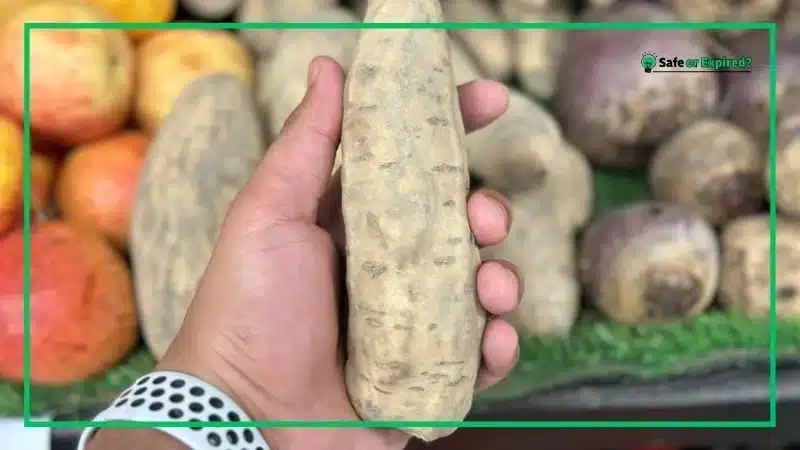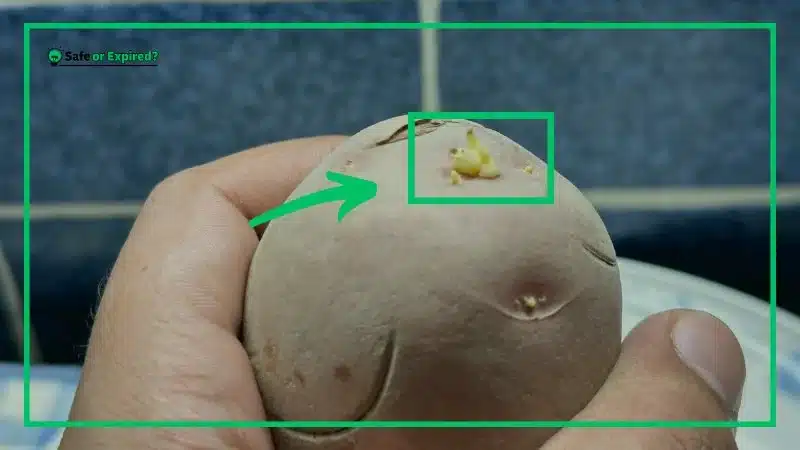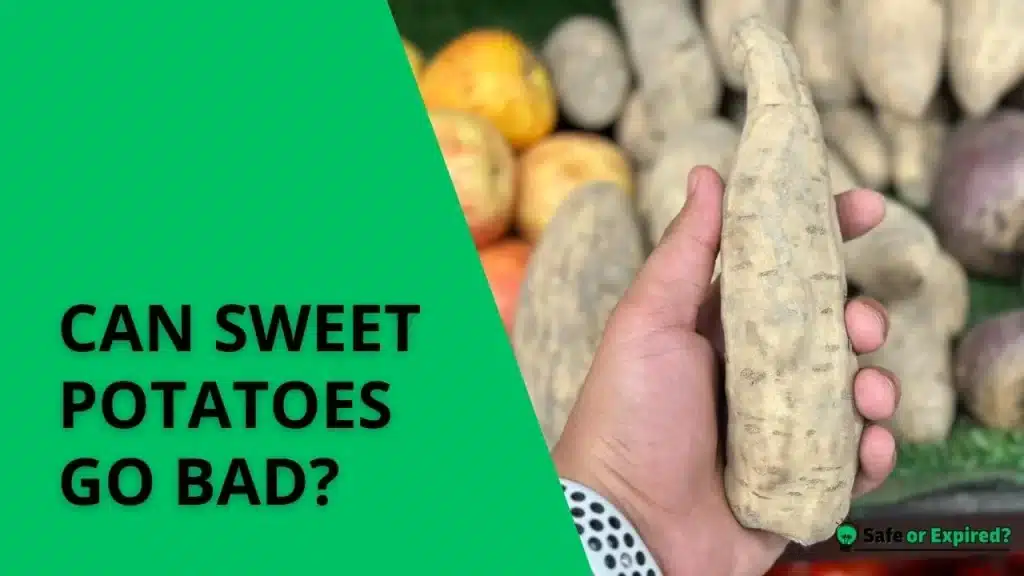“Can sweet potatoes go bad?” is a common question among those trying to maximize their vegetable storage. The answer is yes: sweet potatoes can go bad, and eating spoiled ones can lead to uncomfortable health issues like stomach aches and food poisoning.
But worry not; you will learn all the telltale signs of a bad sweet potato and the potential health risks involved in this guide. Stay tuned!
Can Sweet Potatoes Go Bad?
Yes, sweet potatoes can go bad. Over time, they may develop signs such as a soft texture, foul odor, or discoloration. These changes indicate spoilage due to microbial growth or chemical reactions within the vegetable. Therefore, if they seem abnormal, it’s better to discard them.
Here’s what top-quality sweet potatoes look like.

But the thing is, there are so many kinds and forms of sweet potatoes today. Do they all go bad? Let’s find out.
Do Sweet Potatoes Go Bad After Cutting?
Once cut, sweet potatoes can spoil more quickly. Exposure to air accelerates the oxidation process, leading to discoloration and the potential growth of mold if not stored properly. Note that cut sweet potatoes should be used promptly to avoid spoilage.
Different factors can make sweet potatoes go bad sooner. Discover these reasons/factors in “What Causes Food to Spoil?“
Can Sweet Potatoes Go Bad in the Fridge? (Know the Answer)
Sweet potatoes can go bad in the fridge, especially if stored improperly. Low temperatures slow down decay but do not stop it. In the fridge, sweet potatoes may eventually develop a hard texture or show signs of mold growth, which are clear indicators of spoilage.
Can Cooked Sweet Potatoes Go Bad?
Cooked sweet potatoes can definitely go bad. If left at room temperature for more than 2 hours, cooked sweet potatoes are prone to bacterial growth. In the refrigerator, they typically last for about 5 to 7 days before any signs of spoilage, such as a sour smell or mold, appear.
Can Mashed Sweet Potatoes Go Bad?
Mashed sweet potatoes can go bad, especially if left out for extended periods. In the refrigerator, they may last several days but are susceptible to spoilage from bacteria or mold. Indicators of spoilage include an off smell, a change in texture, or visible mold growth on the surface of the mashed sweet potatoes.
Can Frozen Sweet Potatoes Go Bad?
Frozen sweet potatoes can deteriorate in quality over time. While freezing prolongs their shelf life significantly, they are not immune to freezer burn or flavor loss. If sweet potatoes show ice crystals or have a dry, leathery texture after thawing, their quality has been compromised, though they might not be ‘spoiled’ in the traditional sense.
Can Roasted Sweet Potatoes Go Bad?
Roasted sweet potatoes can go bad. When stored in the refrigerator, they usually remain safe to eat for up to a week. Signs that roasted sweet potatoes have spoiled include a mushy texture, off-odor, or the presence of mold. These should be discarded to avoid health risks associated with spoiled food.
Will Sweet Potatoes Go Bad if Left Out Overnight?
Leaving sweet potatoes out overnight exposes them to room temperature, which can facilitate the growth of microorganisms. At room temperature, bacteria multiply rapidly, and sweet potatoes left in this range for more than two hours can become unsafe to eat.
Additionally, humidity and exposure to air can start natural degradation processes even in a single night. While they may not show immediate signs of spoilage after just one night, the safety and quality of sweet potatoes left out can be compromised, making them potentially hazardous for consumption.

Do Sweet Potatoes Go Bad After Peeling?
Peeling sweet potatoes exposes their flesh to air, initiating the oxidation process more rapidly than if the skin were left intact. Once peeled, the sweet potatoes’ natural barriers are removed, increasing their vulnerability to environmental factors that can lead to degradation.
This exposure does not immediately spoil sweet potatoes, but it accelerates the changes in their texture and taste. Therefore, peeled sweet potatoes might not immediately go bad but are likely to deteriorate in quality faster compared to their unpeeled counterparts. Proper storage after peeling is crucial to maintain their edibility for a longer period.
People often wonder, “Do sweet potatoes turn brown after peeling?” Yes, sweet potatoes do turn brown after peeling. This browning occurs because when the flesh of the sweet potato is exposed to air, it undergoes a process called oxidation. This is the same natural reaction that causes apples and other fruits to brown after their skins are removed.
How Long Does Sweet Potato Last? Key Details
Sweet potatoes typically last for about 3 to 5 weeks at room temperature and up to 2 to 3 months when stored in a dark, and well-ventilated area. Their shelf life varies depending on the initial freshness and the storage conditions.
How Long Does Sweet Potato Last Once Cooked?
Cooked sweet potatoes generally last for 5 to 7 days in the refrigerator. If stored in an airtight container, they maintain quality and taste while being protected from environmental factors that could hasten spoilage. Their longevity can vary slightly based on the specific cooking method used.
Now you know that proper storage extends the life of cooked sweet potatoes. For easy and effective tips, see “Essential Food Storage Tips.”
How Long Do Sweet Potatoes Last at Room Temperature?
Sweet potatoes can last at room temperature, typically for about 3 to 5 weeks. The ambient environment, such as humidity and light exposure, can influence this duration. Sweet potatoes stored in a cool, dry, and dark area away from direct sunlight maintain their quality longer than those kept in warmer, more humid conditions.
How Long Do Sweet Potatoes Last in the Fridge?
In the refrigerator, sweet potatoes can last anywhere from 2 to 3 months. The cooler fridge temperatures slow down the degradation process significantly compared to room temperature, allowing for extended preservation. However, refrigeration is generally recommended only if the sweet potatoes are not used within a few weeks of purchase.
How Long Do Cooked Sweet Potatoes Last?
Cooked sweet potatoes, when stored properly in the refrigerator in airtight containers, can be kept safely for about 5 to 7 days. The storage environment in the fridge should be stable, with minimal temperature fluctuations, to maintain optimal preservation and prevent any rapid microbial growth that could lead to spoilage.
Here’s a shelf life table summarizing the longevity of sweet potatoes under different conditions:
| Storage Condition | Shelf Life |
| Uncooked Sweet Potatoes at Room Temperature | 3 to 5 weeks |
| Uncooked Sweet Potatoes in the Fridge | 2 to 3 months |
| Cooked Sweet Potatoes in the Fridge | 5 to 7 days |
| Cooked Sweet Potatoes at Room Temperature (not recommended) | 2 hours max (safety concern) |
Do Canned Sweet Potatoes Go Bad?
Yes, canned sweet potatoes can go bad. They have a long shelf life, typically lasting up to 2 years unopened. Once opened, they should be consumed within a week. Cans showing signs like bulging, leakage, or a foul odor should be discarded, as these indicate spoilage.
Canned sweet potatoes are sealed and preserved in a can, which allows them to last much longer than fresh sweet potatoes. Typically, an unopened can of sweet potatoes can last for 1 to 2 years or even longer if kept in a cool, dry place.
Once opened, however, they should be transferred to a different container if not used immediately and stored in the refrigerator. Here, they can last for about 5 to 7 days. The main signs that canned sweet potatoes have gone bad include a bulging can, a bad odor once opened, or any visible mold or discoloration inside the can. These signs indicate that the canned sweet potatoes should not be eaten.
Can Sweet Potato Pie Go Bad?
Yes, sweet potato pie can go bad. Like other baked goods that include perishable ingredients, sweet potato pie should be consumed within a few days of baking. It can be stored in the refrigerator for about 3 to 5 days.
If the pie emits an off smell, has visible mold, or the texture has significantly changed, it should be discarded to avoid potential foodborne illness.
How To Tell if a Sweet Potato Is Bad? (3 Signs)
To tell if a sweet potato is bad, check for several signs: a soft, mushy texture, discoloration or dark spots on the skin, and a foul or unusual odor. These indicators suggest spoilage and that the sweet potato should not be consumed.
Softness
When sweet potatoes go bad, they often become spongy or mushy. If you press on the sweet potato and it feels soft or yields easily under pressure, this is a sign of decay. The internal flesh may also appear wetter than normal, which can indicate the presence of rot or internal spoilage. Moreover, you may see sprouting on the outside.

Discoloration
A healthy sweet potato should have a uniform color. If you notice any black spots, fungi, mold, or significant color changes from its original hue, it is likely spoiled. Discoloration can appear on the skin as well as on the inside flesh of the sweet potato.
So, how to tell if a sweet potato is bad inside? Well, just make a slight cut. Brown or black areas inside the sweet potato often suggest that oxidation has occurred, which can lead to spoilage. To get the idea, you can go online and search “pictures of bad sweet potatoes.”
Off Smell
A fresh sweet potato should have a mild, earthy smell. If the potato emits a sour or foul odor, this is a clear indicator that it has gone bad. The unpleasant smell is due to bacterial or fungal growth, which accelerates when the sweet potato starts to rot. Discard any sweet potato that smells off to ensure safety and quality in your dishes.
Remember that all of these things can be avoided if you follow basic food safety guidelines.
What Happens if You Eat a Bad Sweet Potato?
Eating a bad sweet potato can lead to foodborne illness. Symptoms might include stomach discomfort, nausea, vomiting, and diarrhea. These occur because spoiled sweet potatoes can harbor harmful bacteria and mold. If the sweet potato has an off smell, appearance, or texture, it’s best to discard it to avoid health risks.
Conclusion
In summary, sweet potatoes do go bad, and it’s crucial to recognize the signs of spoilage to avoid them. Here are the key takeaways from the discussion:
- Health Risks: Consuming bad sweet potatoes can cause mild stomach discomfort and food poisoning.
- Signs of Spoilage: Be vigilant about softness, discoloration, and an unusual odor. These signs indicate that sweet potatoes are no longer safe to eat.
- Storage Matters: Proper storage extends the shelf life of sweet potatoes. Ensure they are kept in a cool, dry place to maintain their freshness.
- Safety First: Always inspect sweet potatoes before use, and when in doubt, throw them out to prevent health risks.
Understanding how to spot and handle spoiled sweet potatoes ensures you enjoy their benefits without risking your health.

